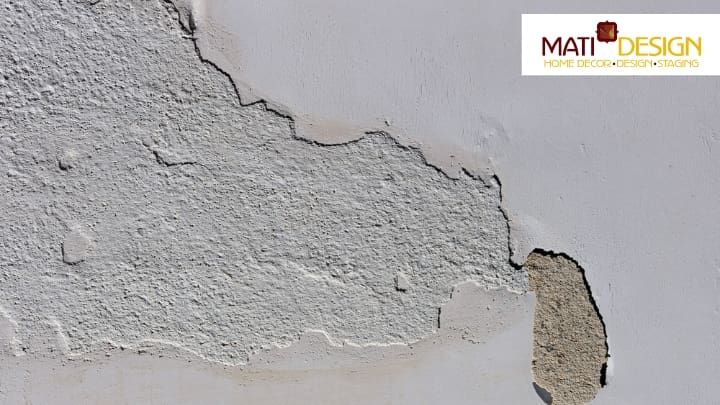
When you think about stucco, you might imagine the exterior of a gorgeous seaside home in Greece or Spain.
Or maybe you’re imagining a vacation home in Florida you enjoy.
But there are plenty of homes with stucco walls here in London Ontario as well.
You might even live in one.
If you do, you know that just like any wall, stucco will succumb to wear and tear over time.
But that’s okay – we’re here to help.
Here at MatiDesign, we specialise in home decor and design in London Ontario.
That includes interior and exterior residential painting.
In today’s article, we’ll be taking a look a how to refresh your home’s stucco with a new coat of paint.
Of course, if you’re not into the DIY approach, we’re here to help get it done for you.
Before you start painting or to hire a contractor, though it’s helpful to understand what stucco really is.
What Is Stucco?
Stucco is a construction material used as a wall covering.
Its main ingredients are water, cement, and sand, though sometimes limestone is used instead of cement.
Traditional stucco is actually the same thing as plaster.
We usually say that if it’s used inside your home, it’s plaster, and if it’s used outside, it’s stucco.
Different Stucco Finishes
There are many different ways to use stucco as well.
You can use a smooth finish, or include patterns in your stucco.
That includes lace, dash, worm, and sandy textures.
You can also use pebbledash style, which is when you mix small pebbles into your stucco.
Types Of Stucco
Did you know there are different types of stucco?
There’s traditional stucco, which we mentioned above.
But there’s also synthetic stucco.
Synthetic stucco is a more flexible substance that contains acrylic resin.
The key difference between traditional stucco and synthetic stucco is that synthetic stucco doesn’t contain cement or lime.
Benefits Of Stucco
One of the great things about stucco is that it can be applied to almost anything.
You can apply a stucco finish to brick, concrete, steel, wood, and more.
It’s also relatively inexpensive, compared to brick or stone.
That’s especially true when you consider its durability.
If you apply your stucco properly and maintain it, you can keep it for up to 50 years.
It’s also more resistant to fire, heat, sun damage, and mildew than vinyl siding.
And of course, it looks great.
But over time, it can lose its lustre, like anything.
How To Paint Stucco
Now that you know more about stucco, you’re almost ready to start painting over your existing stucco.
Let’s take a look at how to do it, step by step.
1. Gather The Tools You’ll Need To Paint Stucco
Some of the tools and materials required for painting stucco are common items that you might already have in your toolbox from previous painting or handy work.
Others you may need to hunt down from your local hardware store.
Before you can paint over stucco, you’ll need to wash it.
A pressure washer is great for this.
You can wash it by hand as well, of course, but a pressure washer makes it much easier.
You’ll also need to be able to reach the entire surface area where the stucco is, so it’s a good idea to have an extension ladder readily available.
Other tools and materials you’ll need to get the job done include:
- A paint roller cage and paint roller covers (thick-napped)
- A caulking gun and acrylic exterior caulk
- Paint brushes and acrylic latex exterior paint (flat finish)
- Sandpaper (80 or 100 grit)
- Acrylic latex block filler (for priming)
Once you’ve got your materials in place, you’re ready to start the painting process.
2. Look For Cracks In Your Stucco Wall
Before you pickup any of your tools, you first need to some inspection work.
Have you noticed any cracks in your stucco?
Don’t panic.
Hairline cracks are vertical cracks that run from the corner of your doors or windows to the ground.
They might look a little bit like lightning bolts.
But because stucco isn’t structural in nature, a couple of hairline cracks are usually nothing to worry about.
Often, these small cracks will fill when you paint over the stucco or can be repaired easily by other means.
However, here are some signs of potential trouble with your stucco:
Discolored Stucco
Watch for unusual discolorations in your stucco.
In particular, watch for them in patches.
This may be a sign of mildew buildup.
While stucco is resistant to mildew, it’s not immune.
Missing Pieces Of Stucco
If you’re missing pieces of stucco in your wall, your stucco may be starting to crumble.
You may be able to get away with filling them in temporarily, but it’s a good idea to consider replacing your stucco walls in this case.
Horizontal Cracks In Your Stucco
Stucco normally cracks a little bit vertically.
But if you’re getting horizontal cracks in your stucco, it may be a sign the structure of your home is moving.
That can indicate a much larger issue with your home, one that needs attention from a professional home renovator or even a structural architect.
3. Wash Your Stucco
Assuming your stucco is in pretty good shape, the next step is to wash it.
This is when your pressure washer will come into play.
If you try painting over dirt or debris on your wall, the paint won’t stick as well.
It will also not look as clean.
Use the lowest setting on your pressure washer during this.
Once the entire surface is clean, let it dry fully before you move onto the next step.

4. Repair Your Stucco Where Needed
Now that your stucco is clean and dry, let’s repair your stucco where it’s needed.
You can use exterior acrylic caulk for smaller cracks, but you might need a stucco patch for larger cracks.
Remember, this is different than drywall putty, so don’t just use the same stuff you’ve had sitting around from when you painted your baseboards.
The other type of caulk you can use during this stage is polyurethane caulk to support waterproofing around your windows and doors.
Remember, if the cracks are really noticeable or look discolored, the damage might be more serious.
If you’ve painted your stucco before and the paint job has started to crack, you can lightly sand the edges of the chipped areas with sandpaper to remove the chips.
5. Prime Your Stucco
When you complete a standard interior paint job on the walls in your home, you use a primer to make it the best paint job possible.
Similarly, if you haven’t painted over your stucco before, it’s helpful to apply an acrylic latex block filler to maximize the coverage of your top coat.
Make sure you read the manufacturers directions for the best outcome before applying the primer.
6. Paint Your Stucco
It’s finally time to paint your stucco.
If you’re painting the exterior, you’ll want to be mindful of the paint manufacturer’s directions for the ideal temperatures to paint in.
It’s good idea to look at the weather forecast to ensure a storm won’t roll through partway into your day.
To ease into the process, it’s best to start with a paintbrush and work around doors, windows and other trim.
When you’re finished with the brush, you can use the thick napped roller to paint in small sections starting at the top and working your way down.
If you used primer, you probably won’t need more than one coat of paint, but if you didn’t it’s possible you may need to add a second coat.
Book Your Consultation With MatiDesign Today
Of course, there’s much more to maintaining a beautiful home than just a coat of paint.
Here at MatiDesign, we’re your one stop shop for everything related to residential design and décor.
From painting to renovations, plumbing to flooring, kitchens, bathrooms, and so much more, we’re here to help.
Book your consultation with MatiDesign today.


